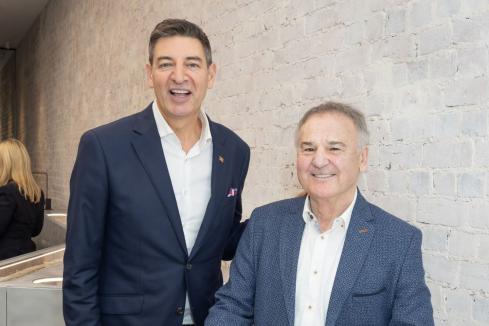Suburban shopping centres are becoming the most sought-after asset class in property.


Suburban shopping centres are becoming the most sought-after asset class in property.
As director of a property fund estimated to be worth more than $2 billion, Primewest’s John Bond is under considerable pressure to provide returns to investors.
And that’s not an easy task given the current property market, with residential and commercial assets quickly coming off the boil in Western Australia.
But Mr Bond told Business News there was always one buoyant section of the property market, even in times of economic uncertainty.
“We like neighbourhood shopping centres,” Mr Bond said.
“They are typically anchored by a Coles or a Woolworths, so we see it as a secure investment.
“If people are anxious about the way the market is going, it’s a good place to put your money and not feel like it’s at risk.
“I think defensive assets are going to stay in demand while people are worried about where the economy is going to go.”
He said the reason neighbourhood centres were such a secure investment was because they weren’t subject to discretionary spending; instead the stores and services on offer were every day staples that were are always in demand.
Notwithstanding that, Mr Bond said there had been a definite shift in the leasing mix of neighbourhood centres in recent years, with less fashion and goods and more services and medical offerings.
“There is a range of tenants that come and go, that’s just the nature of that asset,” he said.
“As trends change and demographics change over time, you’ve seen the video stores, the Blockbusters and that sorts of thing disappear, you’ve seen nail places come in, and there is more food now in the centres than there used to be.”
Primewest recently closed a deal to acquire the just completed Caversham Village Shopping Centre for $26.5 million, adding to a burgeoning retail portfolio (see Business News shopping centres list online).
Mr Bond said the acquisition was indicative of Primewest’s wider strategy to buy assets in growth areas.
“There are a lot of houses being built around it so we would expect it to generate good returns over time as the area is built out,” he said.
“Southern River is another classic example of that strategy; when we bought in five or six years ago it was a very new suburb and it’s really doing very well.”
Neighbourhood centres are also a big focus for property developers in WA, again because of slowing demand for residential and commercial office projects.
There are eight neighbourhood shopping centres currently under construction in the Perth metropolitan area, following the recent completion of Devwest Group’s Wattle Grove development, which is anchor-tenanted by Aldi.
Devwest also completed a neighbourhood centre at Dawesville in January last year, with director Chad Ferguson saying retail was becoming an increasingly important part of the developer and fund manager’s portfolio.
However, Mr Ferguson said developing a suburban mall wasn’t always a straightforward proposition despite the underlying demand.
“It’s really hard to find neighbourhood centre sites for a start; then when you do find them, usually the land price just doesn’t make the project viable,” Mr Ferguson told Business News.
“It’s still really hard to make them stack up.”
Mr Ferguson also said that targeting a high-growth area was no guarantee of investment success.
“With these centres, there is always a fine line between building them and then not having the catchment, or waiting for the catchment to be there, but then someone will beat you to it,” he said.
“It’s a tricky balancing act.”
Perth-based developer Hawaiian is another with a strong focus on neighbourhood centres, with its catchment providing blanket coverage in a 20-kilometre radius of Perth CBD.
Managing director Russell Gibbs said Hawaiian was constantly on the lookout for new acquisitions, however, new assets of the neighbourhood class were always hotly contested when they came to market.
But while expanding the portfolio is important, Mr Gibbs said ensuring an existing centre’s offering was compelling enough to draw shoppers away from the bigger retail facilities was a key element for Hawaiian.
“A big part of our philosophy is about making a difference by connecting people and places with property people,” he said.
“The sort of stuff that we’re doing is trying to create an environment where you can hang out with your family, or you could have a chance meeting with your next door neighbour or someone from down the street, which you’re probably not going to get at a large shopping centre.
“We try to create spaces where people can actually connect with their local community.”
Specific ways Hawaiian fostered relationships, Mr Gibbs said, was by providing unique and bespoke food and beverage options, while also giving consumers an opportunity to get something at Hawaiian’s malls that they couldn’t get elsewhere.
“Not to criticise those retailers, but if I live seven kilometres from a centre and they both have a Nando’s, why would I drive past one Nando’s to go to a Nando’s at another centre?” he said.
“Whereas if you’re a coffee connoisseur, you’ll drive an extra few kilometres to get a really unique coffee or locally roasted coffee beans.
“Our focus is to provide interesting retailers, that’s not just in the food space, but in the fashion space as well.”
Mr Gibbs said Hawaiian was also mindful of the impact of the big centre expansions, with all of Perth’s major malls in line for significant upgrades (see page 18).
He said Hawaiian had a suite of measures in place to ensure it had a compelling offer to not only retain tenants, but attract new ones amid considerable competition.
“We try to give a very personalised service,” Mr Gibbs said.
“In each of our centres, we have what we call service manager, and I’d say that’s pretty unheard of for centres of that size.
“I’m not talking about a property manager, this is someone whose sole job is to help customers or retailers if they have a problem.
“We also have been working with Iain Lawless, the celebrity chef, who works with our food operators to help improve their offering.”
















